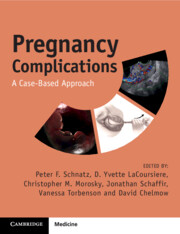Book contents
- Pregnancy Complications
- Pregnancy Complications
- Copyright page
- Contents
- Contributors
- Preface
- Note from the Editor-in-Chief
- Normal Laboratory Values (Conventional Units) []
- Section 1 Antepartum (Early Pregnancy)
- Case 1 A Patient of Ashkenazi Jewish Ancestry Presents for Preconception Counseling
- Case 2 A Patient with a Subchorionic Hematoma Presents with Early Vaginal Bleeding
- Case 3 A 25-Year-Old with a Twin Gestation at 9 Weeks
- Case 4 A 35-Year-Old with HSIL Cervical Cytology at 10 Weeks
- Case 5 A 20-Year-Old with a Molar Pregnancy at 8 Weeks
- Case 6 A 20-Year-Old with Anxiety and Depression at 7 Weeks
- Case 7 A 40-Year-Old with Nausea, Vomiting, and Weight Loss at 7 Weeks
- Case 8 A 30-Year-Old with Worsening Migraine Headaches at 14 Weeks
- Case 9 A 30-Year-Old with Isoimmunization at 9 Weeks
- Case 10 A 25-Year-Old with an Early Pregnancy and Bicornuate Uterus
- Case 11 Recommended Vaccinations at an 8-Week Prenatal Intake
- Section 2 Antepartum (Mid-trimester)
- Section 3 Antepartum (Late Pregnancy)
- Section 4 Antepartum (Medical Complications)
- Section 5 Antepartum (Infectious Complications)
- Section 6 Intrapartum/Delivery
- Section 7 Postpartum
- Section 8 Fetal Complications
- Section 9 Placental Complications
- Section 10 Complications of the Cord, Amnion, and Gravid Uterus
- Section 11 Psychosocial Considerations
- Index
- References
Case 9 - A 30-Year-Old with Isoimmunization at 9 Weeks
from Section 1 - Antepartum (Early Pregnancy)
Published online by Cambridge University Press: 08 April 2025
- Pregnancy Complications
- Pregnancy Complications
- Copyright page
- Contents
- Contributors
- Preface
- Note from the Editor-in-Chief
- Normal Laboratory Values (Conventional Units) []
- Section 1 Antepartum (Early Pregnancy)
- Case 1 A Patient of Ashkenazi Jewish Ancestry Presents for Preconception Counseling
- Case 2 A Patient with a Subchorionic Hematoma Presents with Early Vaginal Bleeding
- Case 3 A 25-Year-Old with a Twin Gestation at 9 Weeks
- Case 4 A 35-Year-Old with HSIL Cervical Cytology at 10 Weeks
- Case 5 A 20-Year-Old with a Molar Pregnancy at 8 Weeks
- Case 6 A 20-Year-Old with Anxiety and Depression at 7 Weeks
- Case 7 A 40-Year-Old with Nausea, Vomiting, and Weight Loss at 7 Weeks
- Case 8 A 30-Year-Old with Worsening Migraine Headaches at 14 Weeks
- Case 9 A 30-Year-Old with Isoimmunization at 9 Weeks
- Case 10 A 25-Year-Old with an Early Pregnancy and Bicornuate Uterus
- Case 11 Recommended Vaccinations at an 8-Week Prenatal Intake
- Section 2 Antepartum (Mid-trimester)
- Section 3 Antepartum (Late Pregnancy)
- Section 4 Antepartum (Medical Complications)
- Section 5 Antepartum (Infectious Complications)
- Section 6 Intrapartum/Delivery
- Section 7 Postpartum
- Section 8 Fetal Complications
- Section 9 Placental Complications
- Section 10 Complications of the Cord, Amnion, and Gravid Uterus
- Section 11 Psychosocial Considerations
- Index
- References
Summary
Isoimmunization is a complication of pregnancy due to exposure to a foreign blood group antigen, with subsequent immunological response directed toward the fetal erythrocytes. This can cause fetal anemia, hydrops fetalis, and fetal death in subsequent pregnancies. Anti-D, anti-E, and anti-Kell are the most common causes of isoimmunization. All pregnant patients should be screened with a type and screen at the first prenatal visit and again at 28 weeks. When possible, a positive screen should prompt paternal genotyping to determine if the fetus is at risk. If the fetus is determined to be at risk, serial titers should be followed. If the critical threshold is crossed, monitoring should transition to weekly surveillance of middle cerebral artery peak systolic velocity. Values greater than 1.5 multiples of the median represent moderate to high risk of fetal anemia. This should be evaluated with cordocentesis and treated with intrauterine transfusion if confirmed. Rh D isoimmunization can be prevented by administration of Rh immune globulin at 28 weeks gestation, postpartum, and at the time of any additional sensitizing events. Quantification of fetal blood cells after a sensitizing event is paramount to ensure appropriate dosing, as suboptimal dosing can lead to sensitization.
Keywords
- Type
- Chapter
- Information
- Pregnancy ComplicationsA Case-Based Approach, pp. 26 - 28Publisher: Cambridge University PressPrint publication year: 2025

